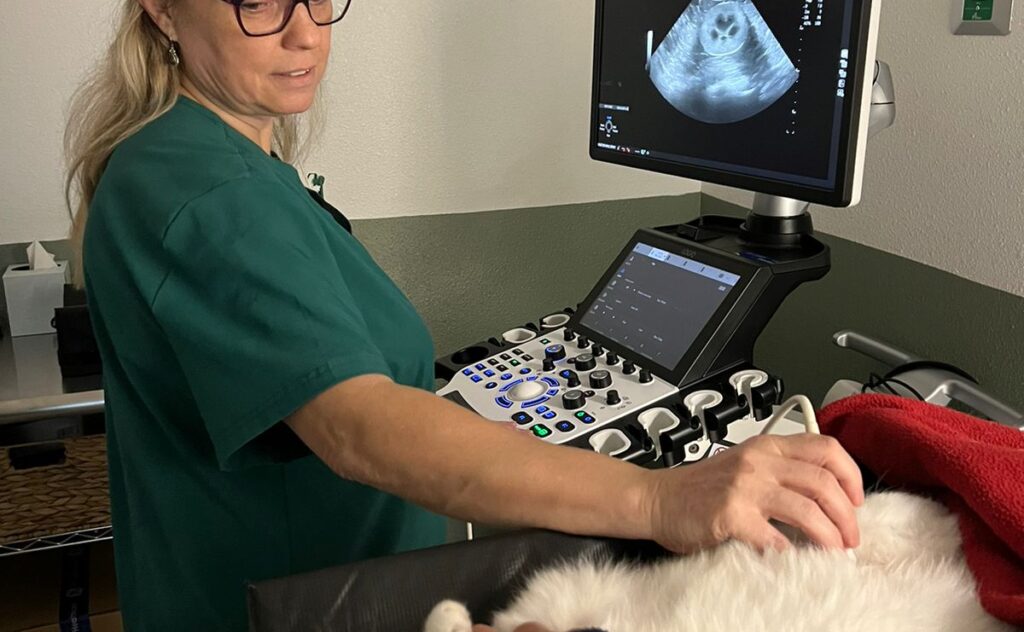In emergency veterinary medicine, a rapid and accurate diagnosis is essential to saving lives. Fortunately, technological advancements allow us to assess the health of our pets more efficiently and in greater detail than ever before. This article explores the vital role of diagnostic technologies, such as ultrasound, computed tomography (CT), and X-ray, in emergency veterinary situations, explaining how each works and their importance for animal health.
Ultrasound: Visualizing Internal Structures
Ultrasound is a fundamental tool in veterinary medicine as it uses high-frequency sound waves to create images of the pet’s internal structures. This technology is especially useful because it is non-invasive and safe, providing real-time results. During the examination, a transducer is passed over the pet’s body area. This device emits sound waves that are reflected by internal tissues. The return of these waves is then converted into images, allowing detailed visualization of organs, blood vessels, and soft tissues.
In emergency situations, ultrasound plays a crucial role in abdominal assessment, allowing the detection of obstructions, tumors, or free fluids in the abdominal cavity. Additionally, it is an essential tool in cardiology as it evaluates cardiac function and identifies problems such as heart failure or valve diseases. In cases of trauma, ultrasound can detect internal bleeding or organ ruptures, providing vital information for quick and effective treatment decisions.
Computed Tomography (CT): Detailed 3D Images
Computed tomography, known as CT, offers a highly detailed view of the pet’s internal structures. Using X-rays, CT creates cross-sectional images and can reconstruct them in 3D, providing a thorough analysis of areas difficult to visualize with other methods. During the procedure, the pet is positioned on a table that slides into the CT scanner. The scanner sends multiple X-ray beams from different angles, and a computer compiles these images into detailed cross-sections.
This technology is particularly valuable in emergencies for assessing complex injuries, such as fractures and bone traumas, which may not be easily detectable with simple radiographs. In neurology, CT is used to identify brain tumors, hemorrhages, or other neurological anomalies. The precision of computed tomography allows for detailed diagnoses, fundamental for planning surgical interventions or specific treatments.
X-ray: Quick and Essential Examinations
X-ray is one of the most widely used tools in emergency veterinary medicine due to its ability to provide quick and clear images of the body’s internal structures, especially bones and organs. The process involves passing X-rays through the pet’s body, where they are absorbed to varying degrees by different tissues. This variable absorption creates an image that reveals details based on tissue density.
In emergencies, X-rays are indispensable for detecting fractures, effectively identifying bone breaks and misalignments. They are also useful for locating ingested foreign bodies or those lodged in the pet’s body and assessing pulmonary conditions such as pneumonia or lung collapse. The speed and availability of X-rays make them an essential tool for initial diagnoses, allowing for immediate interventions when necessary.
Count on All 4 Pets Emergency Hospital
We are a 24-hour emergency hospital, operating 365 days a year, providing reference service with highly qualified professionals in their areas.
We have a diagnostic center with computed tomography, X-ray, ultrasound, echocardiogram, electrocardiogram, hematology and urinalysis and we have large and comfortable ICUs and two operating rooms.
Our offices are designed and developed for the comfort of our clients. In addition to a generous wooded outdoor area, designed for dogs to relax with their owners during the visit. Our entire environment is prepared and equipped with what your pets need, when they need it. We seek to offer great comfort and hospitality in our services.







